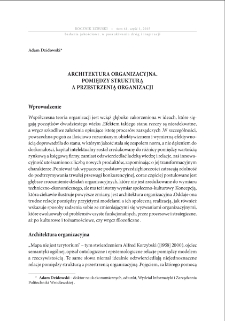Repozytorium Uniwersytetu Zielonogórskiego udostępnia 9 312 obiektów cyfrowych
Obiekt
Tytuł: Architektura organizacyjna. Pomiędzy strukturą a przestrzenią organizacji = The organizational architecture.between the structure and the space of the organization
Współtwórca:
Szumigraj, Marcin - red. ; Trębińska-Szumigraj, Ewa - red. ; Zielińska-Pękał, Daria - red.
Tytuł publikacji grupowej:
Streszczenie:
Coraz częściej przedmiotem badań stają się relacje pomiędzy strukturą organizacyjną a przestrzenią pracy. Wynika to z faktu, że od początków naukowego podejścia do zarządzania oba te wymiary ewoluowały, choć nie zawsze w harmonii. O ile mapy organizacyjne (struktury, hierarchie) stają się coraz bardziej rozmyte, tymczasowe i niejasne (za pomocą struktur sieciowych, wirtualnych), o tyle terytoria (budynki, biura, lokalizacje) coraz częściej stają się wyznacznikiem wizerunku, tożsamości i kultury danej organizacji. ; Rozważania na ten temat, zapoczątkowane przez takich autorów jak Foucault czy Lefebvre, doprowadziły do tzw. "zwrotu przestrzennego" w badaniach nad organizacjami. Okazuje się, że te relacje przestrzenne, a także estetyka miejsca pracy znacząco wpływają nie tylko na produktywność, ale także na motywację, innowacyjność, komunikację i relacje pomiędzy pracownikami. Dlatego otwarte pozostaje pytanie, jak zbadać fenomen projektowy, społeczny i kulturowy, jakim jest współczesne biuro czy inna przestrzeń pracy.
Abstract:
The relationship between the organizational structure and the work space are becoming more and more often the focus of research. It results from the fact that, since the beginnings of the scientific approach to management, these both dimensions have evolved, however not always in harmony. As far as the organizational maps (structures, hierarchies) are becoming more and more blurred, temporary and obscure (by means of network, virtual or liquid structures), the territories (buildings, offices, locations) are more often the indictor of image, identity and culture of a given organization. ; The deliberations concerning these issues, initiated by such authors as Foucault or Lefebvre led to the so called "spatial turn" in the research on organizations. It turns out that these spatial relationships as well as the aesthetics of work place significantly influence not only productivity but also motivation, innovativeness, communication and the relationship of power between the employees. That`s why the question, of how to examine the design, social and cultural phenomenon which is the contemporary office and other work space, remains open.
Wydawca:
Zielona Góra: Lubuskie Towarzystwo Naukowe
Format:
Identyfikator zasobu:
Strony:
Źródło:
Rocznik Lubuski, tom 41, część 1
Jezyk:
Prawa do dysponowania publikacją:
Biblioteka Uniwersytetu Zielonogórskiego
Kolekcje, do których przypisany jest obiekt:
- Repozytorium > Jednostki organizacyjne > Wydział Nauk Społecznych
- Repozytorium > Typy utworów > Artykuły
- Repozytorium > Czasopisma naukowe i serie wydawnicze UZ > Rocznik Lubuski
Data ostatniej modyfikacji:
11 lip 2024
Data dodania obiektu:
11 lip 2024
Liczba wyświetleń treści obiektu:
67
Wszystkie dostępne wersje tego obiektu:
https://zbc.uz.zgora.pl/repozytorium/publication/89788
Wyświetl opis w formacie RDF:
Wyświetl opis w formacie OAI-PMH:
Obiekty Podobne
Hajduk, Edward (1932-2015) Hajduk, Fabian Idzikowski, Bogdan - red. Mianowska, Edyta - red.
Jawornicka, Aleksandra Halczak, Bohdan - red. Burda, Bogumiła - red.
Nodzyński, Tomasz Burda, Bogumiła - red. Szymczak, Małgorzata - red.
Tyda, Arkadiusz Dudra, Stefan - red. Pochyły, Piotr - red.
Młodzik, Lilla
Pecuch, Mirosław Kołodziejska, Barbara - red.
Machaj, Irena Leszkowicz-Baczyńska, Żywia - red.
Austen, Agata Zacny, Bogna Moczulska, Marta - red. Preston, Peter- red. jęz. Stankiewicz, Janina - red. nacz. Zmyślony, Roman - red. statyst. Adamczyk, Janusz- red. Skalik, Jan - red.

